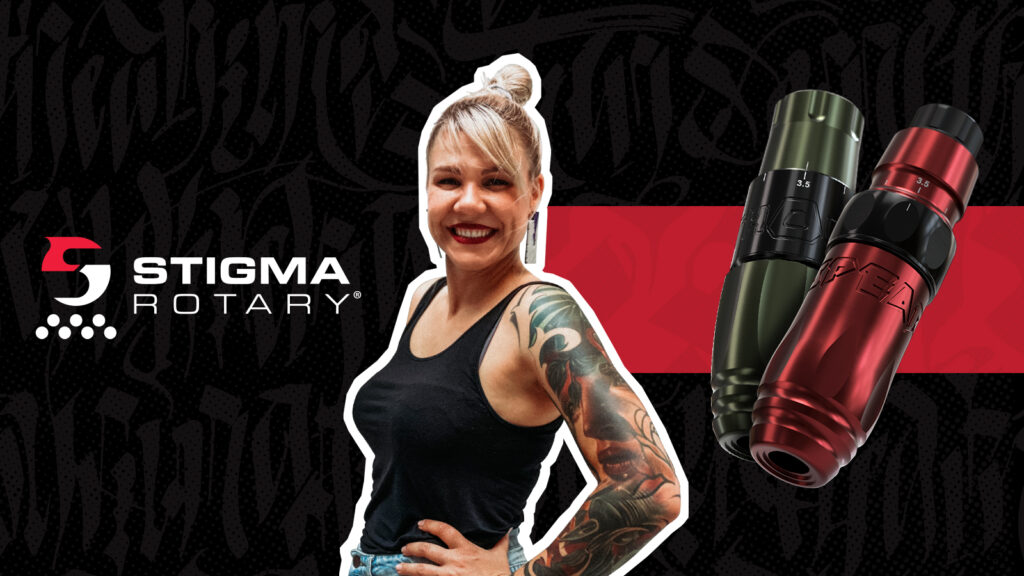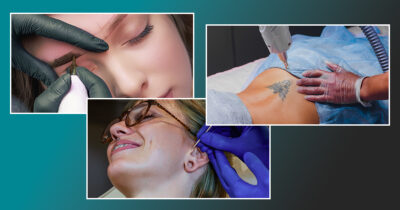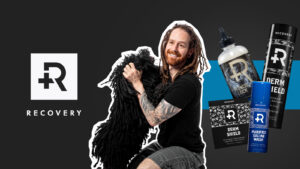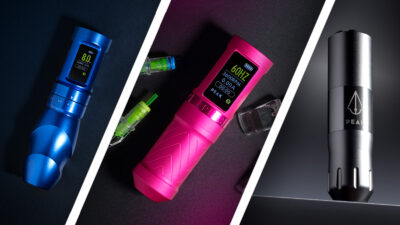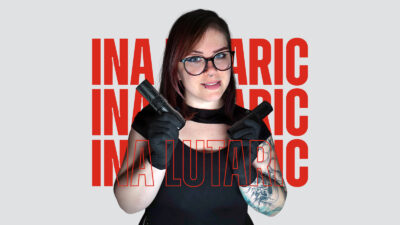Founded in 2005 by tattoo artist and rotary pioneer Artemis Rosakis, Stigma-Rotary® is one of the world’s best known tattoo machine manufacturers.
While every machine is hand assembled in Europe and signed off by Artemis himself, the Stigma® line goes beyond the brand’s signature rotary tattoo machines, extending to power packs, cartridges, grips and footswitches.
We talked to Nora Fangerow, Marketing Director for Stigma-Rotary® and Artemis’ daughter, about how the company began, the Stigma® range of products, and what’s coming next for the company.
Can you tell us the origin story of Stigma-Rotary®?
The founders Artemis Rosakis and Petra Fangerow are both tattooists with over 25 years of experience running their own tattoo studios. At some point in the early 2000s, Artemis started to take his tattoo machines apart and rebuild them - this is when his passion for engineering tattoo equipment was kindled!
Using his many years of experience as a tattooist, his first prototypes were ready in 2003, which he then perfected over two years of testing, struggling, and learning, before he started production.
Stigma-Rotary® was established in 2005 and the first line of machines such as the Fly, Hyper and Bizarre were released to the market and took it by storm. Artemis became famous for his groundbreaking invention of the adjustable give system, and the brand itself astounded the tattoo industry and fascinated many artists that were looking for a lightweight, ergonomic, and quiet tattoo machine that could make their job easier.
What is your connection to the company, and what do you do there?
I am the daughter of the founders and that’s why I feel that I have been part of the company since I was a child. I’ve experienced every step of the journey, admiring my parents’ work and passion, hoping I could one day walk in their shoes. Growing up in the industry has given me the advantage of a deeper understanding of the craft of tattooing, which has helped me identify what a tattoo artist actually wants and needs from their tattoo equipment.
Currently, I am mainly focused on customer relations, especially marketing and customer service, but I also give my insights during the development process of the tattoo equipment, and basically help out wherever I am needed.
Is Artemis still involved in the design process?
Of course! Artemis remains the head developer of every Stigma® model ever made. Together with our R&D manager George Klimatsakis, they create the future of Stigma-Rotary®. Artemis is also responsible for overviewing the production process of the equipment that is being manufactured, and is involved in many departments in various ways.
What are the team like that you work with?
Contrary to the popular misconception that Stigma® is a big corporation, the company, in its core, is and will remain a family business that prioritises the artist’s needs by focusing on manufacturing quality tattoo equipment. In each department there is a group of specialists who each add their own unique input to developing, manufacturing, and marketing Stigma-Rotary® equipment.
Who are some of your favourite tattoo artists?
For a tattoo enthusiast like me, that’s a difficult question. I admire legendary artists such as Lyle Tuttle, Guy Aitchison, Horiyoshi III and Don Ed Hardy, who with their impact made tattooing what it is today. On the other hand, the artists that I truly favour are members of our own ProTeam who I know and cherish, such as Goran Micic, Ivan Panayotov, Dmitry Naboka and Theo Pedrada.
In your opinion, which is the most iconic Stigma-Rotary® tattoo machine?
The most iconic Stigma-Rotary® machine I would say is the Hyper series, which were always innovative and ahead of their time, and are also the most recognised tattoo machines by artists worldwide. Another iconic tattoo machine, in my opinion, would be the Force wireless pen, which marked the beginning of the era of wireless tattooing.
Is size the only difference between the Force and Force XL?
The size and the weight are different. The Force features a grip with 32.4 mm diameter whereas the XL version is more forward weighted and has a 40mm grip.
What’s the difference between the Spear 2.0 and Thorn 2.0, and how did they improve on their originals?
We have completely re-designed and upgraded both the Thorn and the Spear tattoo pens. Both machines now feature a new 8 Watt motor and adjustable stroke on-the-fly, from 2.5 mm all the way to 4.5 mm. The mechanism inside has been completely revamped, resulting in better overall performance as well as lower noise and vibration levels.
As before, you do not need any tools or technical expertise to set a different stroke length. It can be set at any time, even while working, by rotating the motor housing. The rotation stops completely when you reach each end of the range (2.5 mm or 4.5 mm).
The main difference between the Thorn 2.0 and the Spear 2.0 is that the Spear offers adjustable give as well. It’s also very easily adjusted by rotating the top knob with the RCA socket. So, you could say it’s like the “Pro” model while the Thorn remains more compact and user-friendly, with fewer adjustments. Both are compatible with the disposable grips for the original Spear and Thorn models, which are already available.
Which Stigma-Rotary® machines are best for shading, lining and packing respectively?
Adjustability is our signature at Stigma-Rotary®. We strive to create tools that adapt to the artist and not the other way around. We therefore develop machines that can do it all and offer options for everyone.
That’s why both the Thorn 2.0 and Spear 2.0 have adjustable stroke length, and the Spear 2.0 offers even more with adjustable give. The Force is available in three different versions to cover all aspects of tattooing, even PMU.
Will we see a 2.0 version of your Stylist machine?
All I can say is maybe. Right now, I don’t have any further information to share with you about the Stylist.
Are there any plans to create a new version of the Stigma Hyper?
Stigma-Rotary® is known for being innovative and setting progressive industry standards. That’s why we are currently focusing on developing new wireless products and pen machines, rather than a new version of the Hyper machine.
Which size and style of grip have you found most popular with artists?
We always focus on designing ergonomic grips that provide ultimate comfort to the artist throughout their long working days. Following the trends on different sizes and shapes, the grip style on the original Thorn and the Thorn 2.0 tends to be quite popular among the artists who have tried our machines.
Why is it important to keep your machines hand assembled?
Well the human touch is irreplaceable in my opinion. You see, we are passionate about our craft, and prioritise quality over quantity. There are certain aspects in the process of assembling a tattoo machine which require human intuition. Our team of experts check each part pre- and post-production. After a machine is complete, it still has to pass a vigorous quality control before it reaches the customer.
Is your manufacturing still entirely done in Germany and Switzerland?
We have facilities in both Germany and Greece. All our products are designed in Germany, and raw materials and motors are manufactured within the EU and Switzerland.
Have you found the Power Pack to be particularly popular?
The Force and its wireless counterpart, the Power Pack, are both popular within the tattoo community as one of the first wireless machine. Features such as the Digital Give and Boost are still unique to this day.
How does the Pilot footswitch work?
The Pilot Footswitch is a wireless footswitch designed to work with the Force pen and other Stigma-Rotary® products. Sturdy and future proof, it does what you expect from any footswitch: it starts and stops your machine using two methods. The first is called Hold, which allows the Force to run continuously as long as you keep it pressed, and the second one is called Toggle, which will start or stop the machine with a single press.
Do you think people appreciate the flexibility of having both battery packs and cables?
For some artists, the option to be able to switch from a battery to a cable and vice versa is vital. Others, however, don’t really want a cable anymore and prefer to work exclusively with a wireless machine.
Have you considered going into universal-style cartridges?
Using our experience with the Stigma-Rotary® Advanced Safety Cartridges, we are currently in the process of designing new cartridges to fit any machine out there. We will share more exciting information on this in the future!
What do you think the next big thing is in the tattoo industry?
Some things are best kept secret.
Which tattoo artists are really pushing the industry forward?
A couple of years back, there was a shift in the tattoo art world which I consider to be a turning point for the industry. It’s when tattoos began trending and the artform became mainstream, even playing on TV with shows such as Ink Master. At that point, people with an artistic background like Fine Arts graduates turned their interests and business onto tattooing. For me, this is when the art of tattooing evolved immensely.
Ever since then, artists have pushed the bar even further on a daily basis. So even if I name an artist now, by the time the interview is published another artist will have taken it even further!
Do you have any new products lined up you can tell us about?
Due to the wireless revolution, we are also focusing a lot on the software we develop to improve and expand our product line even further. I cannot share anything specific yet, but very soon you will be able to experience first-hand the next generation of Stigma-Rotary® wireless equipment.
What does the future hold for Stigma-Rotary®?
There’s a lot coming to be honest. Thanks to the continuous support we have received, we are currently able to expand and move one of our facilities to a bigger space which will allow us to have an even stronger core team of experts, more manufacturing equipment and manpower. In the future, we aim to significantly strengthen Stigma-Rotary®’s presence in the industry.
Huge thanks to Nora Fangerow for talking us through the whole range and giving us a glimpse into the life of tattoo royalty!
You can follow Stigma-Rotary® on Instagram and Facebook, or check out their collection of tattoo machines, cartridges and grips on the Killer Ink online store.
